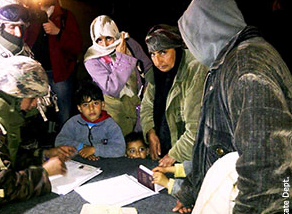The Assistant Secretary of State for Population, Refugees, and Migration Ann Richard visited the region recently as part of a high profile US delegation examining the humanitarian response to the Syria crisis. Their visit coincided with some erroneous rumors on social media that the UN was channelling aid money through the Assad regime. Certain media outlets picked up the falsehood and reported it as fact.
That seems to have prompted this thoughtful missive from the Assistant Secretary which expounds on the challenges and risks of aid workers in Syria–particularly those of UN agencies and the Syrian Red Cross-Red Crescent.
U.N. Bravery in Syria
By Anne Richard Assistant Secretary of State for Population, Refugees, and Migration
During a recent conversation with Syrians living in the Turkish refugee camp of Islahiye, some asked: is it true that the U.N. is handing over hundreds of millions of dollars in aid to the Asad regime? We assured them that this rumor, circulated on social media by opposition supporters, is not true. It is based on a misunderstanding of how the U.N. raises funds and distributes assistance. Aid workers are risking their lives, and doing so with international aid financed in part by the United States, to help Syrians suffering from the brutality of the Asad regime. But this rumor coupled with erroneous reports of American indifference has led to misguided criticisms of the international aid effort. So let’s set the record straight.
The truth is that aid workers are performing heroically to help the Syrian people. The Asad regime may be attempting to pacify parts of Syria and so is now allowing aid into some areas. As a result, relief workers are crossing shifting battle lines and facing very real and very deadly threats.
The stories of civilian carnage are by now familiar. Innocent men, women and children have been caught in the crossfire, massacred by air assaults or militias, and preyed upon by hostage-takers and criminals. Refugees crossing from Syria into northern Jordan told me of “barrel bombs” packed with explosives and dropped on towns and cities in the south that killed or maimed indiscriminately. Doctors, medical clinics and even bakeries have been targeted to undermine the opposition. Sixty thousand people are estimated to have died and many more have been wounded. It is a deadly arena for relief workers, as well, and several have been killed.
John Ging, Operations Director in the U.N.’s Office for the Coordination of Humanitarian Affairs, led a team of emergency directors from seven U.N. agencies into Syria in January. The government would not let them bring aid over the borders from neighboring countries into contested areas, so they were testing the limits of their reach inside Syria. They visited Damascus and the surrounding area, traveled to the cities of Homs and Dara’a and crossed the conflict line north of Homs into Talbiseh.
At the same time, High Commissioner for Refugees Antonio Guterres and his team were working day and night to oversee a risky operation. A convoy of trucks traveled through Syria to reach the far north of the country where 45,000 displaced civilians were living under flimsy tents in makeshift camps beyond the reach of aid workers. A 200-ton convoy moving through the landscape of war is an obvious target. So, the aid convoy traveled in the open, requiring delicate negotiations with the regime in Damascus and opposition factions in control along the route, before reaching Azzaz on January 31 and delivering 2,000 tents and 12,000 blankets.
When the UNHCR trucks arrived, local Syrian Arab Red Crescent (SARC) workers offloaded them and distributed the aid. Some critics have questioned whether the SARC is in the pocket of the Asad government. The truth is that SARC is not monolithic, and loyalties of SARC staff vary, probably mirroring the loyalties of the communities in which they live. It’s also true that SARC workers and volunteers throughout Syria have bravely lived up to the humanitarian tenets of the Red Cross/Red Crescent movement, delivering aid and helping war victims.
At a January 30 conference in Kuwait, some 60 countries came together to pledge $1.5 billion in more humanitarian aid for the U.N.’s efforts, with the United States making a pledge of $155 million. When added to previous funds to address the crisis, the United States is providing a total of $365 million. I met with representatives of one government that were skeptical of the U.N.’s abilities to maneuver in the dicey landscape of Syria. This government was therefore channeling its aid directly to refugees in countries outside Syria – something that I applauded as equally urgent and helpful, although I urged them to coordinate aid with the U.N. to avoid duplicative and wasteful giving. Amidst this generosity, other governments are limiting their aid in response to the crisis. This is a grave mistake. We need more contributions to help those in need, not less, and we must support U.N. agencies and others as they struggle to reach some of the most challenging locations on earth. Failing to do so maligns the courageous efforts of these aid workers and ignores the suffering of innocents experiencing hell-on-earth in Syria.
Anne Richard is the assistant secretary for population, refugees, and migration at the U.S. State Department.
